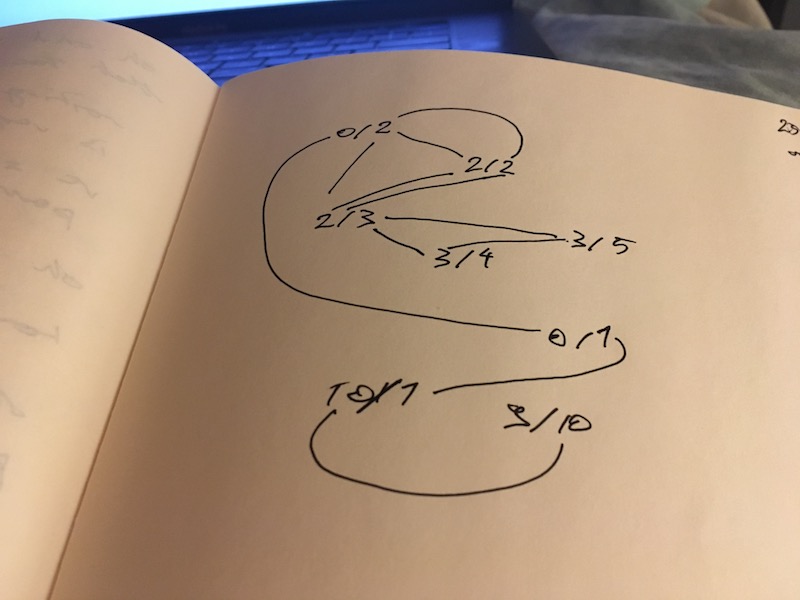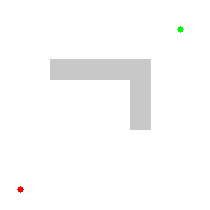On Day 24 of Advent of Code we had to build a path finding algorithm. We're given a set of nodes and a heuristic and have to find the best possible path.
OMG I DID IT! I built a recursive implementation of A* in Haskell all on my own for #AdventOfCode Day 24.
— Swizec Teller (@Swizec) December 25, 2017
Didn't even have to look it up 💪
pic.twitter.com/9j4Iq5VN1u
The puzzle uses different phrasing, but that's what it is.
Build a bridge out of the magnetic components strewn about nearby.
Each component has two ports, one on each end. The ports come in all different types, and only matching types can be connected. You take an inventory of the components by their port types (your puzzle input). Each port is identified by the number of pins it uses; more pins mean a stronger connection for your bridge. A 3/7 component, for example, has a type-3 port on one side, and a type-7 port on the other.
Your side of the pit is metallic; a perfect surface to connect a magnetic, zero-pin port. Because of this, the first port you use must be of type 0. It doesn't matter what type of port you end with; your goal is just to make the bridge as strong as possible.
The strength of a bridge is the sum of the port types in each component. For example, if your bridge is made of components 0/3, 3/7, and 7/4, your bridge has a strength of 0 3 3 7 7 4 = 24.
You can model this as a graph path finding algorithm.
Each component is a node. It connects to all other components with matching pin numbers. Our job is to find the most expensive path in this imaginary graph.
Let's take the test input:
0/2 2/2 2/3 3/4 3/5 0/1 10/1 9/10
With those nodes, our graph of connections looks like this 👇

Sorry that's not laid out the best and I don't have my usual colourful markers on me right now. But that's our graph.
The correct solution in this case is: 0/1--10/1--9/10 for a total strength of 31.
My A* implementation in Haskell
To find that solution we can use the famous A* algorithm, which is itself an improvement on the even more famous Dijkstra algorithm. This is the stuff I used to nerd out on in college. 😇
Now I can't promise my algorithm is a true implementation of A* or of Dijkstra's algorithm. I used what I remembered from college as inspiration and derived the search algorithm from scratch all on my own.

A* search algorithm visualization
It was so much fun that it kept me from my Christmas duties and my girlfriend complained. A lot.
The core of my solution is the recursive buildBridge function. It builds bridges (graph paths) from all possible candidates for the next bridge piece, then chooses the best one.
-- build bridge with maximum score
buildBridge::Int -> [(Int, Int)] -> [(Int, Int)] -> [(Int, Int)]
buildBridge port [] bridge = bridge
buildBridge port pool bridge
| length opts > 0 = maximumBy (comparing heuristic) $ map (\(nextPort, link) ->
buildBridge nextPort (poolWithout link pool) (bridge ++ [link])) opts
| otherwise = bridge
where opts = candidates port pool []
heuristic::[(Int, Int)] -> Int
heuristic links = sum [a b | (a, b) <- links]
That's not the prettiest Haskell code. Here's what it means:
buildBridgeis a function that takes a number, two lists of(number, number)tuples, and returns a list of(number, number)tuples. The number is theportwe're trying to build bridges for, the first list is apoolof available components, and the 3rd list is the currentbridgewe're extending.- if the
poolof available components is empty, return thebridge - build a list of
candidatesfor the next component and put it inopts - if
optshas a length greater than zero, return the best bridge where youbuildBridgefor each candidate component - if there are no available candidates, return the
bridge - the
heuristicfunction sums all ports in the bridge
Each time we go into a recursion, we take components out of the component pool that's passed into buildBridge. That guarantees we don't accidentally use a component multiple times.
I find it difficult to visualize how this algorithm works. 😅 It's something between a breadth first search and Dijkstra's algorithm. Not actually sure it's A* after all 🤔
How it works
For every node, we find all possible nodes we can connect to (its neighbors). For each of those we build a path all the way to the end. This gives us all possible paths through the graph.
Then we unwind the recursion to collapse them into the best possible path.
For the test input, all possible exhaustive paths are:
0/1--10/1--9/10 0/2--2/3--3/4 0/2--2/3--3/5 0/2--2/2--2/3--3/4 0/2--2/2--2/3--3/5
As our recursion unwinds, it picks the best path based on our heuristic function. You can think of that process as replacing nodes with their values and picking the best option.
Step 1
0/1--10/1--19 0/2--2/3--7 0/2--2/3--8 0/2--2/2--2/3--7 0/2--2/2--2/3--8
Step 2
0/1--30 0/2--13 0/2--2/2--13
Step 3
31 15 0/2--17
Step 4
31 15 19
Step 5 31
At each step of unwinding, we can discard low value alternatives when they share the same bridge root. Eventually we end up with a single possibility.
This sounds a lot like the description of A*, but I'm honestly not sure that my algorithm is A*. 😕
The helper functions
Either way, to find those candidates, we use the candidates function:
-- find all possible candidates for next link
candidates::Int -> [(Int, Int)] -> [(Int, (Int, Int))] -> [(Int, (Int, Int))]
candidates port [] acc = acc
candidates port pool acc
| (-1, -1) == link = acc
| otherwise = acc [(nextPort, link)] ++ (candidates port nextPool acc)
where (nextPort, link) = findNext port pool
nextPool = poolWithout link pool
This function takes a port we're connecting to, a pool of components, and the current known list of results, acc.
We use findNext to find the next component we can use, called link. Link because it's going to be a link in the bridge. We take it out of the nextPool of components passed into recursion using poolWithout.
If the link was found, we expand our known list of candidates, acc, with the new link and a call to candidates with the remaining pool.
You may be wondering why we're spending so much time passing ports around instead of nodes. It's because each node is made out of two ports and each port can only be used once. We try to keep track of that.
For instance when we look for candidates to connect to (0, 1) we know that 0 is already used. So we look for anything that can connect to 1. When we find (1,2) and (3,1) we have to note that 1 is used up so the next node will have to connect to either 2 or 3.
The findNext function is where this finding happens.
-- find next link in bridge and which port to use for next next link
findNext::Int -> [(Int, Int)] -> (Int, (Int, Int))
findNext port [] = (port, (-1,-1))
findNext port pool
| port == left = (right, (left, right))
| port == right = (left, (left, right))
| otherwise = findNext port (tail pool)
where (left, right) = head pool
findNext returns the first matching component from our pool. When the pool is empty, it returns (-1, -1) to signify nothing was found.
When the port matches either left or right side of the component, we return that component and the next port it can match to. If left matched, we return (right, (component)), if right matched, then we return (left, (component)).
If nothing matched and there's still stuff in the pool, we return whatever findNext finds in the pool without the first element. Because we checked the first element just now.
Recursion 🤙
The poolWithout function we used in a couple places is a simple filter by they way 👇
poolWithout::(Int, Int) -> [(Int, Int)] -> [(Int, Int)]
poolWithout link pool = filter (\x -> link /= x) pool
And that works
That mass of recursion that's hard to visualize in your mind works. It really does. I'm kinda surprised. It feels like magic.
I mean, I wrote the algorithm. I derived it from scratch. And when I try to think about how it works my mind just goes

Recursion is hard, okay.
So did I build A* or not? This is gonna bother me 😕
PS: star 2
For Star 2, we had to find the longest possible bridge with the best score. Same algorithm, different heuristic function.
heuristic2::[(Int, Int)] -> [(Int, Int)] -> Ordering
heuristic2 a b
| la > lb = LT
| la > lb = GT
| la == lb = compare (heuristic a) (heuristic b)
where la = length a
lb = length b
Compare lengths, if lengths are the same, use the previous heuristic function based on strength.
Continue reading about Advent of Code Day 24 – The A* Algorithm, I think
Semantically similar articles hand-picked by GPT-4
- Advent of Code Day 13, Packet Scanners
- Advent of Code Days 17 & 18 – Spinlocks and Interpreters
- Collatz, Haskell and Memoization
- Aho-Corasick string matching algorithm in Haskell
- Amdahl's law in action - 27s to 0.03s by changing a function
Learned something new?
Read more Software Engineering Lessons from Production
I write articles with real insight into the career and skills of a modern software engineer. "Raw and honest from the heart!" as one reader described them. Fueled by lessons learned over 20 years of building production code for side-projects, small businesses, and hyper growth startups. Both successful and not.
Subscribe below 👇
Software Engineering Lessons from Production
Join Swizec's Newsletter and get insightful emails 💌 on mindsets, tactics, and technical skills for your career. Real lessons from building production software. No bullshit.
"Man, love your simple writing! Yours is the only newsletter I open and only blog that I give a fuck to read & scroll till the end. And wow always take away lessons with me. Inspiring! And very relatable. 👌"
Have a burning question that you think I can answer? Hit me up on twitter and I'll do my best.
Who am I and who do I help? I'm Swizec Teller and I turn coders into engineers with "Raw and honest from the heart!" writing. No bullshit. Real insights into the career and skills of a modern software engineer.
Want to become a true senior engineer? Take ownership, have autonomy, and be a force multiplier on your team. The Senior Engineer Mindset ebook can help 👉 swizec.com/senior-mindset. These are the shifts in mindset that unlocked my career.
Curious about Serverless and the modern backend? Check out Serverless Handbook, for frontend engineers 👉 ServerlessHandbook.dev
Want to Stop copy pasting D3 examples and create data visualizations of your own? Learn how to build scalable dataviz React components your whole team can understand with React for Data Visualization
Want to get my best emails on JavaScript, React, Serverless, Fullstack Web, or Indie Hacking? Check out swizec.com/collections
Did someone amazing share this letter with you? Wonderful! You can sign up for my weekly letters for software engineers on their path to greatness, here: swizec.com/blog
Want to brush up on your modern JavaScript syntax? Check out my interactive cheatsheet: es6cheatsheet.com
By the way, just in case no one has told you it yet today: I love and appreciate you for who you are ❤️
